What is tourism?
- Tourism is travel for recreational (fun), leisure (rest), family, or business purposes, usually of limited duration.
- It refers to the temporary, short-term movement of people to destinations outside their residence places.
- Who is a tourist?
- The World Tourism Organization defines tourists as people “traveling to and staying in places outside their usual environment for not more than one consecutive year for leisure, business, and other purposes”.
- Ecotourism
- Ecotourism is a form of tourism involving “responsible travel to natural areas, conserving the environment, and improving the well-being of the local people“.
- Ecotourism is about uniting conservation, communities, and sustainable travel. This means that those who implement, participate in and market ecotourism activities should adopt the following ecotourism principles:
- Minimize physical, social, behavioral, and psychological impacts.
- Build environmental and cultural awareness and respect.
- Provide positive experiences for both visitors and hosts.
- Provide direct financial benefits for conservation.
- Generate financial benefits for both local people and private industry.
- Deliver memorable interpretative experiences to visitors that help raise sensitivity to host countries’ political, environmental, and social climates.
- Design, construct and operate low-impact facilities.
- Recognize the rights and spiritual beliefs of the Indigenous People in your community and work in partnership with them to create empowerment.
- Sustainable tourism
- The UN World Tourism Organization (UNWTO) defines sustainable tourism as “refer[ring] to the environmental, economic and socio-cultural aspects of tourism development. A suitable balance must be established between these three dimensions to guarantee its long term sustainability.”
- Green Tourism
- Green tourism is defined as environmentally friendly tourism activities with various focuses and meanings. In a broad term, green tourism is about being an environmentally friendly tourist or providing environmentally friendly tourist services.
- Although green tourism sounds eco-friendly, it is quite the opposite today. So, while the term sounds friendly, it’s often used to merely brand a hotel as environmentally friendly without it practicing many sustainability efforts.
- Over the years, the term has earned a bad reputation as many hotels and tours have been using it as a marketing tactic, while not actually doing anything to reduce the damage they have been causing the environment, a practice known as greenwashing. This term is a tag that hotels assign themselves even though they haven’t adopted even the most basic sustainable practices like recycling and water conservation.
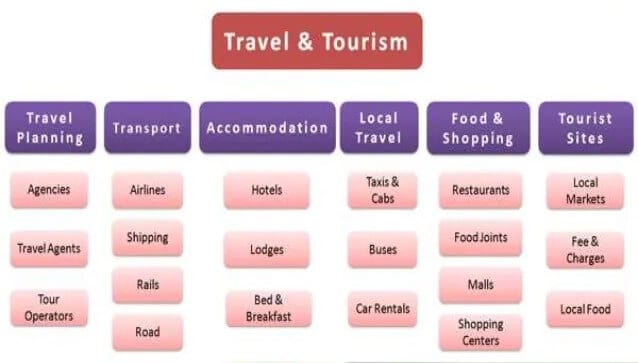
Types of Tourism In India
From bustling modern metropolises to ancient temples, the high peaks of the Himalayas to the warm waters of the Arabian Sea, India is a colorful and diverse country popular with tourists from all over the world. Historic sightseeing, adventure travel, and cultural vacations are all popular types of tourism in India, and many of the country’s top destinations enjoy international renown. Types of Tourism in India is given below:
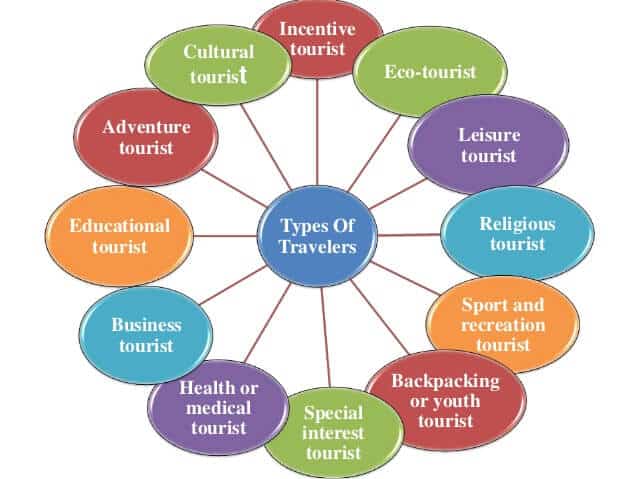
- Nature Tourism:
- India being a peninsula(one of the largest coastline) there a lot of beautiful beaches spread along the coast and in the Indian islands.
- India has a lot of Evergreen forests, filled with a high diversity of Flora and fauna.
- Plenty of Hill stations each providing unique sense of excitement and scenery.
- Places having high scenic beauty:
- Heaven on Earth”- Uttarakhand
- “Paradise on Earth”-Kashmir
- “God’s on Country”- Kerala
- Well Know Places: Shimla, Jammu, Goa, Munnar, Ooty,
- Kodaikanal, Conoor, Shillong, Darjeeling, Mussoorie, Leh-
- Ladakh, Manali, Nanital,
- Heritage / Cultural Tourism: The birthplace of Buddhism and Hinduism and home to hundreds of monasteries and ancient temples, India may be the top destination in the world for spiritual tourism. The holy city of Varanasi sits on the banks of the Ganges River and draws hordes of international tourists to its ghats and towering Hindu temples.
- Wildlife Tourism: India is a land full of unmatched wild treasures. The climatic conditions and geographical features make the country one of the top biodiverse spot on Earth. India Maintains 566 Wildlife sanctuaries, 105 National Parks and 12 Bio Reserves in India (under MAB program of UNESCO). Some of the major wildlife zones of India are:
- Deccan Peninsula
- Western Ghats
- Gangetic Plains
- North Eastern Region
- Himalayan Region
- Adventure Tourism: The mountains of Himalayas are among the most popular destinations on Earth for hikers, mountaineers and climbers, and they offer nearly endless possibilities for trekking adventures.
- Pilgrimage Tourism: In ancient times travel was primarily for pilgrimage as holy places. India is the most popular in pilgrimage tourism because it is the land of every religion. Famous Pilgrimage Places of India is given in table below:
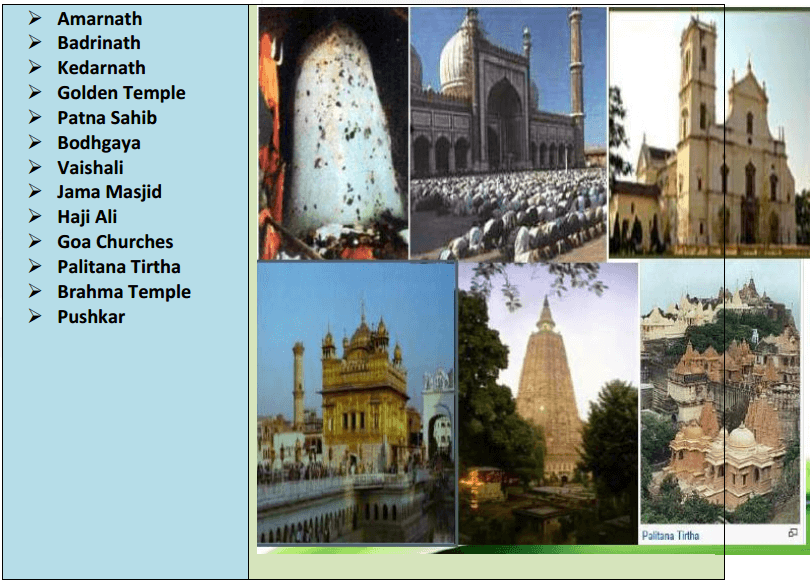
- Medical Tourism
- The medical tourism industry in India is poised to become the next success story after the software/IT industry.
- Medical tourism has boosted with the number of Overseas patients touching 400000 in 2013 as against 10000 in 2000.
- Apollo Hospitals alone has treated 110000 international patients in 2014.
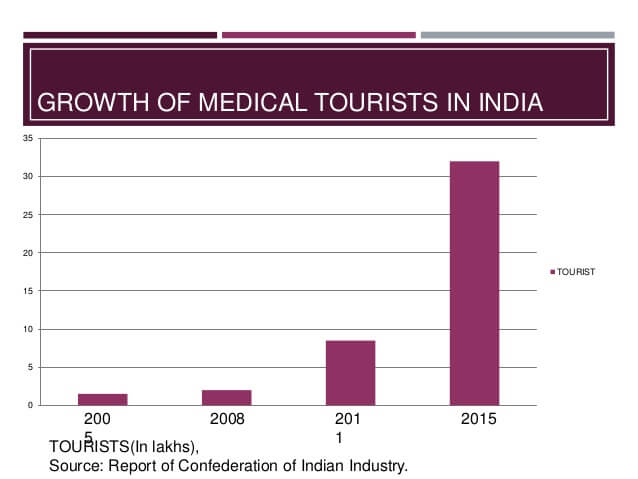
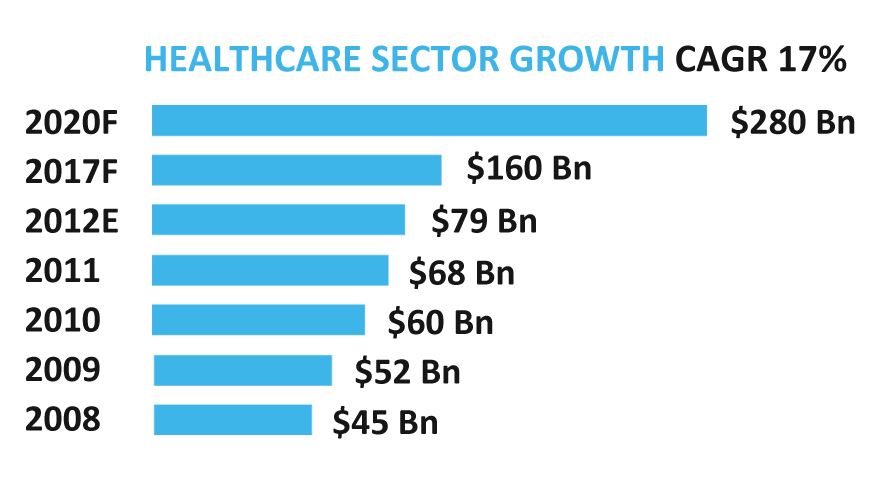
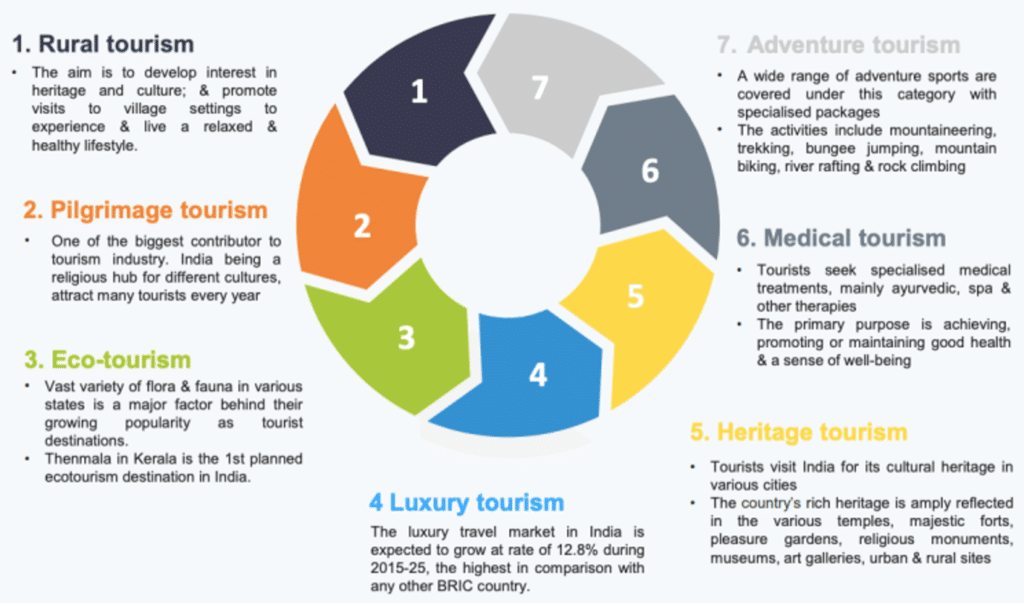
Importance of ‘Tourism’ in India
- Generates Income and Employment: In 2017, Tourism Industry accounted for 8% of the total employment. An increase has been witnessed in the sale of handlooms, handicrafts etc.
- Service Sector: It gives a push to service sector. A large number of businesses engaged in service sector such as airlines, hotel, surface transportation, etc. grows with the growth of tourism industry.
- Foreign Travelers help India in getting Foreign Exchange.
- Tourism helps in preservation of National Heritage and Environment by bringing in focus the importance of sites and need to preserve them.
- Renewal of Cultural Pride: Tourist spots being appreciated globally instills a sense of pride among Indian residents gets reinforced.
- Infrastructural Development: Now-a-days, it is ensured that Travelers do not face any problem; multiple use infrastructures are getting developed at several tourist places. Uttarakhand’s plan to start mobile caravans is a latest example.
- It helps in bringing India on global map of tourism, earning appreciation, recognition and initiates cultural exchange.
- Tourism as a form of soft power, helps in promoting cultural diplomacy, people to people connect and thereby promotes friendship and cooperation between India and other countries.
Scope of Tourism in India
- Tourism in India is the largest service industry, with a contribution of 9.2% of India’s GDP in 2018 and 8.78% of the total employment in India.
- India witnesses more than 17.9 million annual foreign tourist arrivals and 740 million domestic tourism visits. The tourism industry in India generated about 100 US$ billion in 2008 and that is expected to increase to US$275.5 billion by 2018 at a 6.9% annual growth rate.
- According to World Tourism Organization estimates, India will lead in South Asia with 8.9 million arrivals by 2020.
- India is poised to emerge as the 2nd fastest growing (8.8%) tourism economy in the world over 2005-14 according to the World Travel & Tourism.
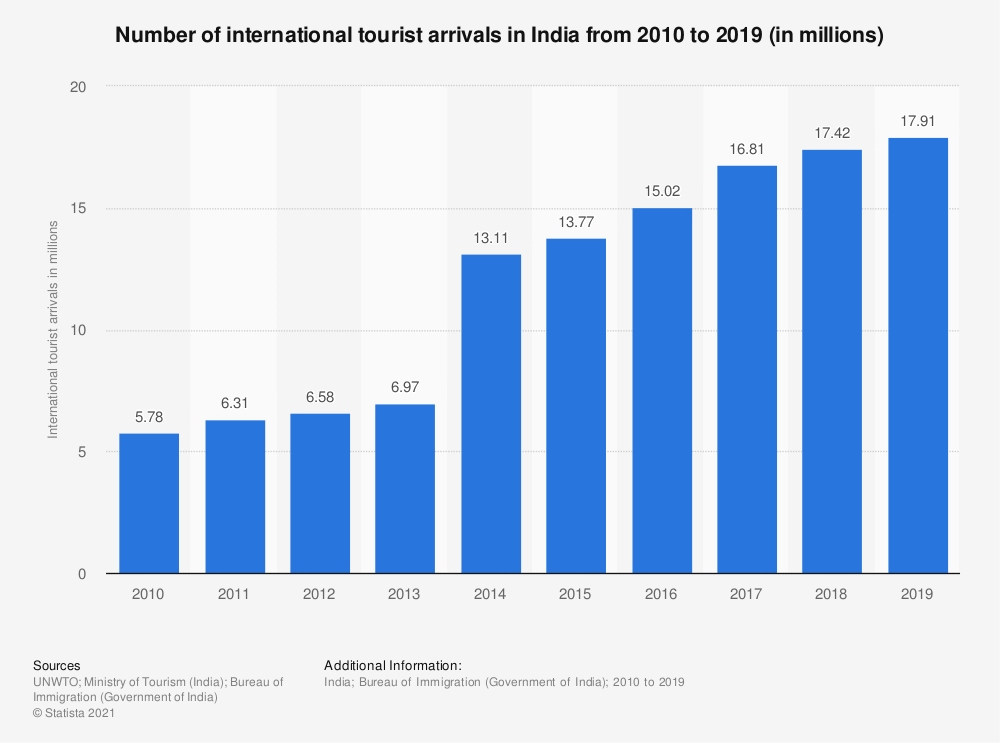
Reasons to Invest
- Tourism in India accounts for 9.2% of the GDP and is the third largest foreign exchange earner for the country.
- India ranks 34th on the World Travel and Tourism Competitiveness Index 2019, released by the World Economic Forum.
- India is the 16th most visited country in the world, with a share of 1.56% in the world’s tourism receipts.
- India has a diverse portfolio of niche tourism products – cruises, adventure, medical, wellness, sports, MICE, eco-tourism, film, rural and religious tourism.
- Domestic tourism contributes to three-fourths of the tourism economy.
- The UNWTO has forecast that the travel and tourism industry in India will grow by 8% per annum between 2008 and 2016.
- Foreign exchange earnings from tourism are likely to show annualized growth of 14% during the same period.
- FDI Policy:
- 100% FDI is allowed under the automatic route in tourism and hospitality, subject to applicable regulations and laws.
- 100% FDI allowed in tourism construction projects, including the development of hotels, resorts and recreational facilities.
- Financial Support
- INR 5 Billion has been allocated towards the proposed creation of 5 tourist circuits around specific themes.
- INR 1 Billion has been allocated towards a National Mission on Pilgrimage Rejuvenation and Spiritual Augmentation (PRASAD), a drive that is to be launched in this financial year.
- INR 2 Billion has been allocated towards National Heritage City Development and Augmentation Yojana (HRIDAY) to be launched for conserving and preserving the heritage character of certain cities.
- INR 1 Billion has been allocated for the preservation of archaeological sites.
- The Budget Allocation for Annual Plan 2015-16 of Ministry of Culture is Rs.1455.00 Crore.
Major Policy Initiative – taken by Indian Government
- Some important timeline in tourism sector in India is given below
- 1988 – Establishment of Ministry of Civil Aviation Tourism.
- 1991 – Tourism as a source of Foreign Investment
- 1992 – National action plan for tourism
- 1999-2000 – Visit India Year
- 2002 – The concept of highway tourism, agricultural tourism, and rural tourism. A campaign titled as Incredible India was launched.
- 2009 – Another campaign titled as Atithi Devo Bhava was introduced
- Initiatives are taken by the government to promote the tourism industry
- In year 2002, the Government of India announced a New Tourism Policy.
- The policy is built around the 7-S Mantra of-
- SWAAGAT (WELCOME)
- SOOCHANAA (INFORMATION)
- SUVIDHAA(FACILITATION)
- SURAKSHAA (SECURITY)
- SAHYOG (COOPERATION)
- SANRACHNAA (INFRASTRUCTURE)
- SAFAAI (CLEANLINESS)
- Promotion Of Indian Tourism
- Incredible India! : – AAMIR KHAN. (Brand Ambassador)
- Gujarat Tourism: – AMITABH BACHCHAN. (B.Amb)
- Kerala Tourism: – Govt. of Kerala (Incredible India!).
- Rajasthan Tourism: – Govt. of Rajasthan (Incredible India!).
- Madhya Pradesh Tourism: – Govt. of MP (Incredible India!).
- Swadesh Darshan Scheme: Under it, the Ministry of Tourism provides Central Financial Assistance (CFA) to State Governments/Union Territory Administrations for infrastructure development of 13 identified theme based circuits.
- 13 Circuits are: North-East India Circuit, Buddhist Circuit, Himalayan Circuit, Coastal Circuit, Krishna Circuit, Desert Circuit, Tribal Circuit, Eco Circuit, Wildlife Circuit, Rural Circuit, Spiritual Circuit, Ramayana Circuit and Heritage Circuit.
- Integrated development of identified pilgrimage destinations (includes employment generation) has been undertaken under the ‘National Mission on Pilgrimage Rejuvenation and Spiritual, Heritage Augmentation Drive’ (PRASHAD) Scheme.
- “Adopt a Heritage Project” plans to entrust heritage sites/monuments and other tourist sites to private sector companies, public sector companies and individuals for the development of various tourist amenities.
- Incredible India Website to promote to and engage with travelers.
- Online Learning Management System for creating skilled manpower to work as tourist facilitators.
Challenges of India’s Tourism Sector
- Infrastructure and Connectivity: Deficiencies in infrastructure and inadequate connectivity hamper tourist visits to some heritage sites. For example, many tourist destinations like Kangchenjunga, are still not easily accessible.
- Low-cost hotels: The hotels and holiday homes are not up to the mark and are marred by unhygienic conditions and lack proper sanitation.
- Absence of basic amenities like drinking water, well maintained toilets, first aid, cafeteria etc. at tourist places.
- Skill Deficit: The number of adequately trained individuals for the tourism and hospitality sector is a key challenge to giving visitors a world-class experience.
- Entry/exit Issue: Despite the introduction of an e-visa facility, visitors find the process of applying for a visa still cumbersome.
- Promotion and Marketing: Although marketing related to India’s tourism has been increasing, still online marketing/branding remains limited and campaigns are not coordinated.
- Safety- Tourists have frequently been mugged and robbed or cheated in India and also have returned without any justice.
- Seasonality in Tourism, with the busy season being limited to six months from October to March and heavy rush in November and December.
- Non-acceptance of International Cards at small outlets.
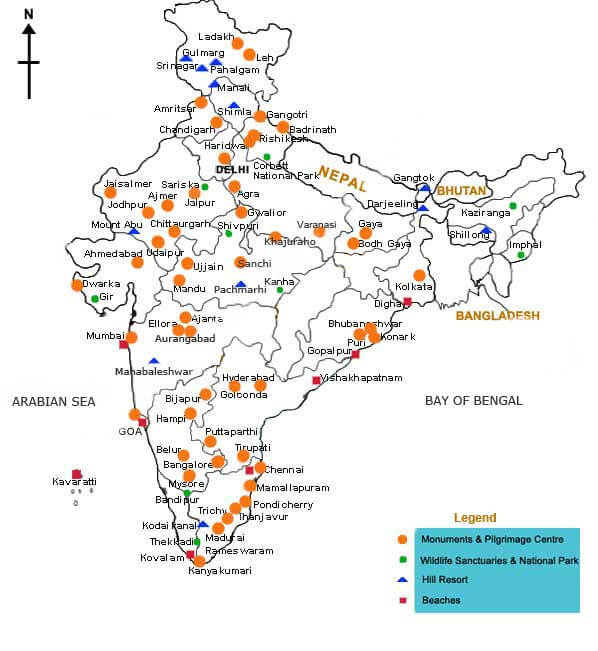
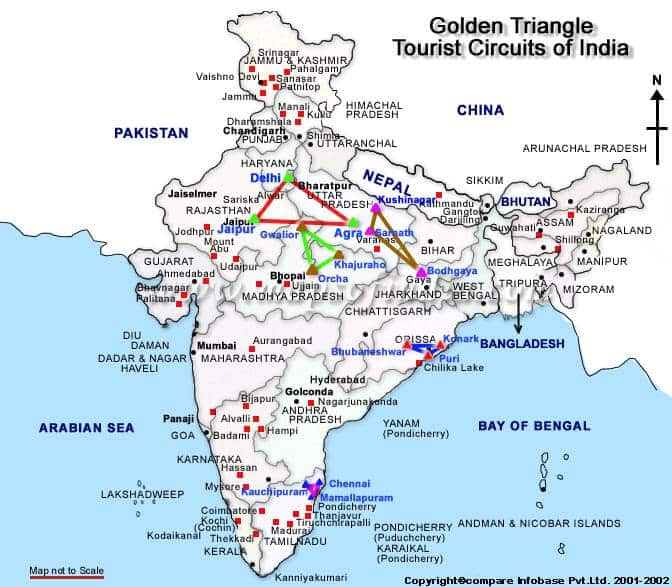
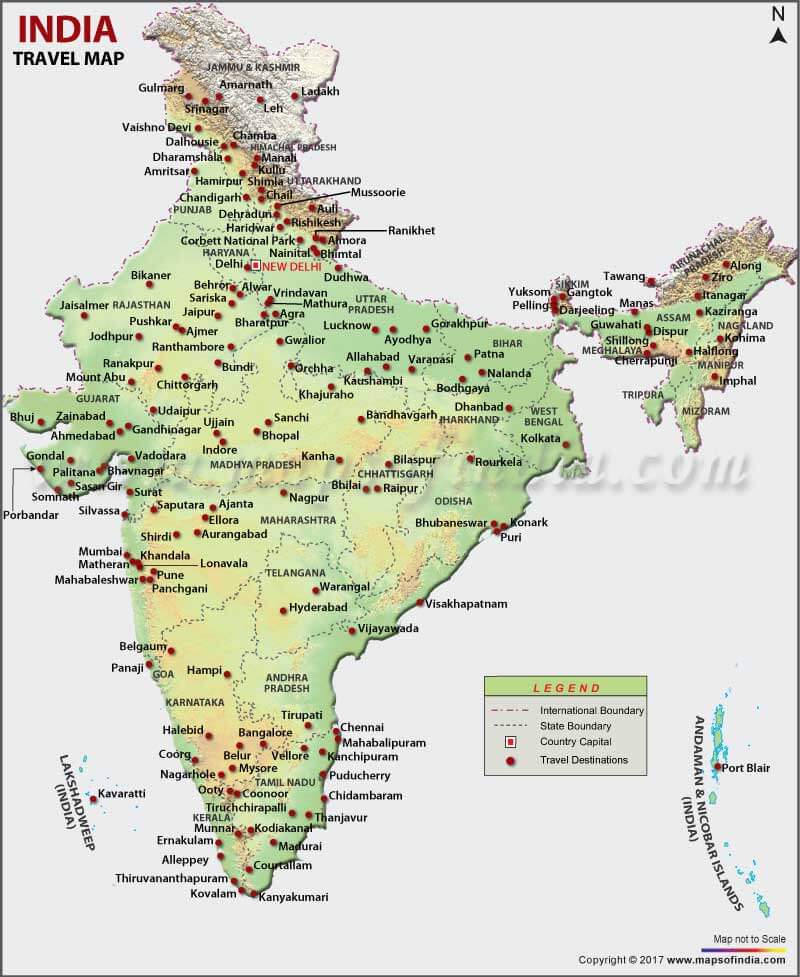
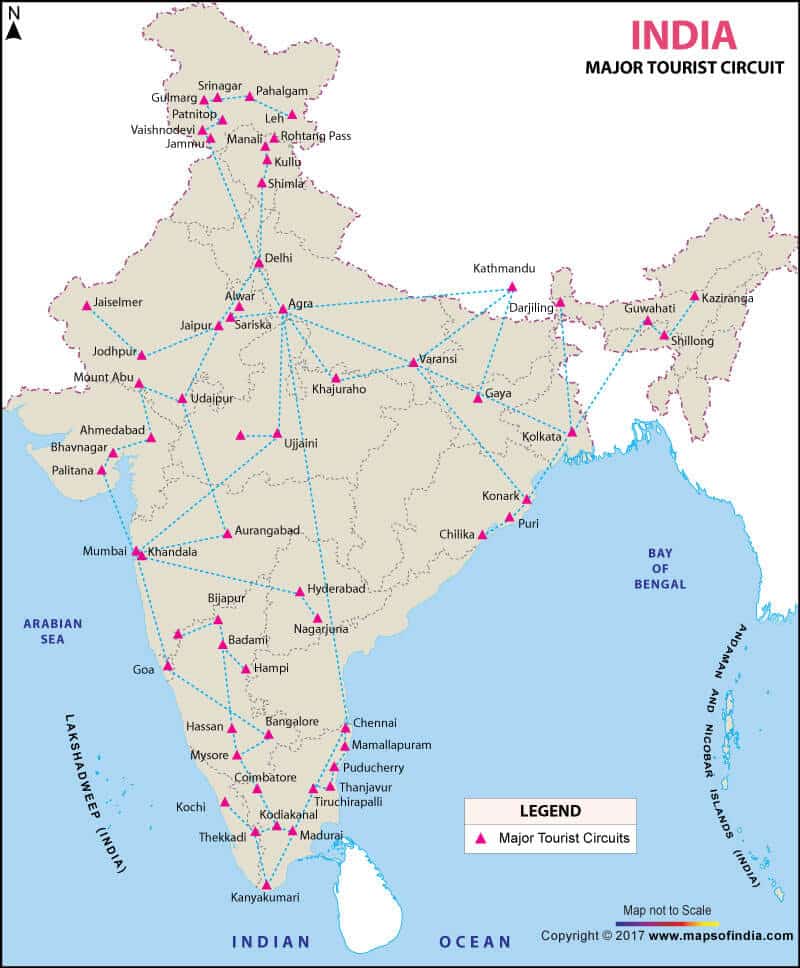
Way Forward
- Faster development of all sort of infrastructure (physical, social and digital) is a need of hour.
- Safety of tourists is a priority. An official guide system can be launched for tourists.
- Indian Residents should be motivated to treat tourists well, so that tourists don’t face any type of fraud.
- Promotion of other forms of Tourism like Medical Tourism, Adventure Tourism etc. to solve the problem of seasonality. Off-season concession is another solution.
- India’s size and massive natural, geographic, cultural and artistic diversity offers enormous opportunities. Indian Tourism industry should play on that.
